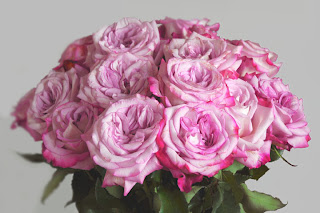 The Shortage of Roses in 2010
The Shortage of Roses in 2010
For professionals working in the floral industry, 2010 has been a year when certain flowers have become scarce and in some cases hard to get at any price. Roses in particular are becoming increasingly scarce and some varieties are taking on the cult status of rare rookie trading cards. Well, that's a sight exaggeration, but you get my drift. In this short essay I have outlined the main causes and what we can expect for the next couple of years.
The output of roses produced in Ecuador and Colombia this year, when compared with the last ten years, represents somewhat of an anomaly, yet in light of current events and the passage of time will most probably be viewed as a significant market correction. The fact that we have witnessed so much economic upheaval in every area of commerce within the USA as well as globally would lead one to logically expect corrections in the floral industry, and we can now see that this is in fact happening in all major growing and distribution zones.
The following factors have had an impact on a decreased rose supply, and which may be summarized in five major categories, namely; Climate; Access to Capital; Fluctuating Exchange Rates; Mass Market Contracts; & Increased Demand Worldwide.
Climate
Whether one subscribes to global warming or global cooling, a Democrat climate conspiracy or a Republican denial of weather statistics; there is no doubt that the whole planet is experiencing climate change. In Ecuador specifically, and also in Colombia but to a somewhat lesser extent, the countries have experienced uncharacteristic and prolonged periods of cold weather, with significant amounts of rainfall and with a net result of a dramatic reduction in luminosity. This component is required for the plants well-being and to ensure rapid, healthy growth of the plants. Normally in the equatorial countries at the elevations at which flowers are grown there is normally a significant amount of sunlight, but this year and over the last 12 months really, it may be said, that the reduction in days of normal luminosity is now wreaking havoc in production.
For many years the Eastern Seaboard, Rust Belt and Midwest received a significant amount of their roses from Colombia. However, that country’s production is dropping rapidly due to causes outlined in this summary, which means that more buyers are turning to Ecuador to augment their supply.
Access to Capital
Just as gaining access to business loans in the USA has become very difficult, in Colombia and Ecuador they have become almost impossible to secure. With the economic downturn, horticulture in general is now viewed as a risky segment, and banks are unwilling to invest or make loans to the flower plantations.
In Colombia the situation has become exacerbated by their strengthening currency, the “Peso”, which has meant that flowers sold today yield less in returns when the accounts are settled after 30-60 days. Over the last 12 months this trend has really put the screws into production, with several farms declaring bankruptcy and several more simply closing their doors. While the Colombian producers are desirous to raise prices, the prevailing pessimism of the world economies has meant that this has been very hard to do.
For some farms, the situation is further compounded by having long term contracts with supermarkets and the probable outcome of trying to raise prices with supermarkets is most likely to lead to a loss of the account. Some of the larger enterprises did in fact receive loans from the Colombian National Bank a couple of years ago, but again the unfavorable exchange rates has meant that servicing the loans has become increasingly difficult. This has lead to a major player Falcon Farms CI declaring bankruptcy October 11th in Colombia, and seemingly abandoning the farm and replacing it with another very large one in Ecuador. This single thread of events tightened the market a little more, as the farm they acquired had been selling for the wholesale markets and is now selling exclusively to Falcon Miami and their mass market accounts.
Exchange Rates
As outlined above, the Dollar-Colombian Peso exchange rate has had a negative effect on the flower producers’ ability to be profitable, as the monthly difference cut into their bottom line. The solid, well financed farms with good cash-flow and aggressive marketing strategies (and of which there are relatively few) have sought to offset the downside of trade with the USA by finding new partners in Europe, Russia and Japan.
In Ecuador, where they have had solid relationships with Europe and Russia for some time, the fact that they are a dollar-based currency has impacted the sales curve this year as follows: In Holland, where traditionally flower imports are weak in the summer, they were down substantially in volume and sales as the dollar strengthened against the Euro.
However, this has started to shift as the winter season approaches with purchases rising much higher than normal as the Euro is now getting dramatically stronger, having risen almost 15% in the last month.
Russia on the other hand, fueled by an economy that is driven by energy reserves has bought more roses so far this year than at any other time in their history.
Also note that as the Australian Dollar, the New Zealand Dollar and the Euro all get stronger, we import less from those countries, which puts even more pressure on the available supply of more affordable imports from South America as well as that of domestic production.
Mass Market Contracts
Most supermarkets, big box stores and on-line fulfillment operators negotiate flower prices and quantities anywhere from 3 months to one year in advance. The buyers drive very hard negotiations predicated on large volumes, and they expect the vendors to fulfill their end of the deal. Many of these agreements are in fact encapsulated in legal documents that have provisions for stiff financial penalties if orders are not fulfilled. At present, there is a distinct push from the bouquet makers to locate products that fit into the parameters outlined by their mass market clients as well the price points. At present, it seems that there is enormous pressure on many bouquet makers to fulfill the contracts and remain profitable. Recently a large provider in Miami, Superior Floral, simply had to close the doors as they were unable to turn a profit. I suspect that larger players are keeping their clients happy until it comes time to renegotiate prices. And prices will have to go up. The growers will insist on this, particularly as there are now other options available to them. Furthermore, the amount of legitimate plantations that can fulfill orders to the customers’ expectations in terms of volume and quality is also shrinking.
Increased Worldwide Demand
As recently as seven years ago the USA used to absorb about 60% of the rose production of Ecuador and from Colombia a figure in the region of 90%. In 2010 through August USA received about 32% of the rose production in tons from Ecuador, although this was valued at 29% in dollar value. Russia has purchased a little over 18% in the same period, a quantity which has almost doubled since 2007.
Colombia is actively soliciting offers from Europe and Russia, and although they are now shipping many carnations to other countries, they have been less successful with roses due to quality issues. On the whole most of the rose production from Colombia is still shipped to the USA, but a larger percentage is going to the mass markets.
France, Italy, Ukraine, Canada, Germany, Switzerland and Japan are starting to import more and more roses from Ecuador, and these countries are atop a list of some 50 countries bringing in 10,000 tons or more.
This strategy of diversification is a sound one and ensures better returns for the farms, but it does mean that in the global marketplace the probability that flowers may go to other parts of the world is increasing, and in the nature of capitalism the better roses and hot varieties tend to be siphoned off to the highest bidder.
It should also be noted that Russia tends to have a group of varieties that only appeal to them, which may be generalized as having long stems, large heads and gaudy tow-tone colorations. The fact that some growers are allocating large chunks of their farms to growing these varieties, and harvesting them in a completely different way means that less acreage is available for the USA and other markets.
Conclusions
Any one of these categories on its own would constrict the rose supply, but when one considers that a combination of all these things is now occurring the result is clearly a substantially impaired rose supply. The fact that the rose supply is now possibly less than demand for the first time in twenty years must inevitably lead to increased prices.
It is also becoming patently clear that as the top tier of thirty or so farms in Ecuador start to leave the other farms behind (in terms of product composition, high quality standards and marketing integrity), and find that the demand for their exclusive, newer varieties and higher quality continues to sell out; that they can raise their prices and sell to the highest bidder. With the internet, this means it could be a buyer in Kazakhstan, South Korea or Canada!
This also encourages the second class farms to raise their prices, since for many rose buyers they represent the only chance to procure substantial quantities of product, being shut-out of the top tier. These farms are able to successfully raise prices because of the comparative nature of our business.
And likewise the lower class of farms can ask prices for product that is marginal.
CAN THERE BE ANY DOUBT THAT PRICES AT THE WHOLESALE LEVEL MUST GO UP?
In years past, the response to tight supply and increased demand resulted in a reciprocal increase in new farms, or the addition of more growing hectares by existing farms. However, at this time there has been no such response, as any substantial inversion of capital in floriculture has been cancelled or postponed due to lack of liquidity and the uneasiness and uncertainty of the economic future within the USDA, as well as Ecuador, Colombia and indeed the entire world.
Finally, while I can imagine a few surges in production occurring on occasion, I do not believe that there will be any increase in production for several years. This will also have a knock -on effect, as designers resort to other flowers to fulfill their needs, which will in turn lead to a market that is driven by demand for the first time in almost thirty years!!


































